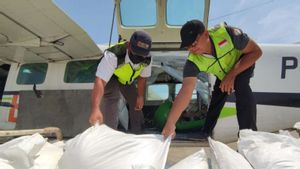JAKARTA - Officially, the COVID-19 pandemic was recorded to have entered Indonesia in early March. Not a few doubted that. Some experts estimate the virus had entered before cases 01 and 02 in Depok, West Java. However, however, what is clear is that the government has made many mistakes in its precautionary measures. We fail to learn, even from one of the biggest outbreaks we've ever had: cholera.
Harvard epidemiologist Professor Marc Lipsitch created a model that concluded that COVID-19 entered Indonesia earlier than the authorities announced. From within the country, the teaching staff at the Faculty of Public Health (FKM), University of Indonesia (UI), Pandu Riono even detailed that COVID-19 had entered Indonesia since January.
This is not the first time. In the 19th century in colonial times, when a cholera epidemic attacked the Dutch East Indies, a historian named Anthony Reid strongly opposed many of the statements of the Dutch colonial government. One of the things that Reid highlighted the most was the slow response from the government.
In his book entitled Southeast Asia in Kurun Niaga volume I (1988), Reid wrote, the colonial government was often slow to detect the presence of an epidemic. "Severe cholera in the form of asiatica or morbus is usually thought to have not reached Southeast Asia before the severe pandemic of 1820-1822," wrote.
History records how the government in the archipelago has always been slow to prevent and deal with epidemics. "The reasons for this view, as with similar views on the bubonic plague prior to 1911, are inconclusive," Reid, writes.
Reid concluded that the delay was because Dutch historical sources noted that the founder of Batavia, Jan Pieterszoon Coen, died of a tropical disease suspected of being cholera in 1629. For Reid, it was clear. Cholera epidemics had entered before the 19th century. However, because the settlements at that time were not very dense, cholera was difficult to endemic.
Plague
The beginning of cholera began to plague massively, none other than when the Governor General of the Dutch East Indies, Herman Willem Daendels, who ruled from 1808 to 1811, began to move the center of government from Oud Batavia - Old Batavia or the Kota Tua area - to the Nieuw Batavia Weltevreden area, the region. around the Banteng Square.
Alwi Shahab, in his book Batavia Kota Hantu (2010), explains that the transfer was carried out because at that time Oud Batavia was considered a hotbed of disease. "The relocation was carried out because the city center by the coast had become a hotbed of disease. Some call it the 'grave' of the Dutch. "
For some time, this option was considered appropriate. Moving from a malaria-prone city to a place where the water supply is better. However, in fact, even with better housing, their lack of understanding of the disease and the absence of medication have kept many people stricken with cholera. The Europeans in Batavia were no exception.
The History of Disease Eradication in Indonesia (2007) published by the Indonesian Ministry of Health describes cholera as a disease that attacks the large intestine with early symptoms of high fever, stomach cramps, vomiting, and acute diarrhea. With all these clinical symptoms, cholera becomes a deadly disease if not treated immediately.
In line with the above symptoms, the natives at that time called cholera a vomiting disease. Meanwhile, the Dutch called cholera with the term "bort". Meanwhile, the English call it the pronunciation "cholera".
The development of the plague was allegedly due to a dirty environment and poor sanitation. One of the reasons is none other than the number of houses in Batavia that do not have latrines or bathrooms. All sewage and sewage flow directly into the canals. The condition of the canal at that time was exacerbated by the waste disposal of the arak distillery and sugarcane mills. As a result, the canal was so smelly and muddy.
It is not surprising, then, that cholera caused great panic for the Europeans in Batavia. Moreover, when he knew the malignant picture of cholera at that time. The fatality rate of the cholera epidemic of 1821 is described in the notes of the colonial official of indigenous affairs, Roorda Van Eysinga, entitled Verschillende Reizen en Lotgevallen (1830).
"There were days when in Batavia 160 people died (from cholera). They had severe convulsions and died a short time later… I was lucky not to have contracted it and saw many of my patients recovering well. However, I was so exhausted that I could barely keep working, ”Roorda wrote.
“In this very hot climate, it is very difficult to care for lower social class patients who usually live in small brick-walled rooms. The room should be tightly closed to prevent airflow. Then, the patients should be bathed in warm water. I instructed the sufferers to be rubbed with wine and sometimes I did it myself if there were not enough people, "he added.
As a result, cholera, which was considered a new disease, provoked an unusual response from the community, both natives and those of Chinese descent - two common names for the two groups of people who dominated the Batavian population at that time. Susan Abeyasekere, in her book that was banned during the New Order era, Jakarta: A History (1989), reveals that both the natives and the Chinese people believe in magical things to fight cholera.
“Individualistic Indonesians rely on 'holy water', namely water that comes from kramat locations or has been recited by Islamic religious leaders. There are also those who hold mass rituals to ward off disease. "
Unlike the Chinese, their unusual way was to call a lion dance to get around Chinatown if there was a threat of a cholera outbreak. "They believe that the demon that spreads cholera is afraid of the lion dance," concluded Susan.
The English, Chinese, Japanese, Arabic, and French versions are automatically generated by the AI. So there may still be inaccuracies in translating, please always see Indonesian as our main language. (system supported by DigitalSiber.id)










